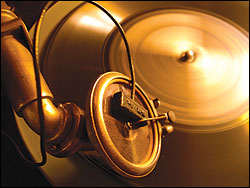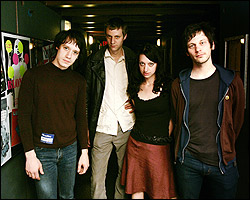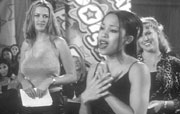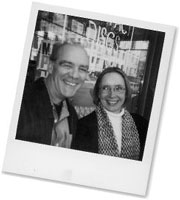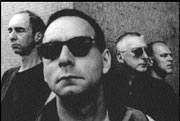“I never saw ‘music’ as being much different than ‘art,'” says local composer, sound artist, producer, and Jack Straw Arts Manager Steve Peters. “The overlap of the two in Fluxus, futurism, Dada, [and] performance art was normal to me, and I was as influenced by all of that as I was by music. The distinction between ‘music’ and ‘sound’ is mainly one of convenience.”
While Peters doesn’t presume to speak for any of the other artists who will conflate sonic and visual imagery for “In Resonance,” Bumbershoot’s first sound-art exhibit, his reasoning could be offered to visitors approaching the multiple, commingling, noise-emitting installations in the Rainier Room. The show’s goal is to create an immersive experience combining tonality, anti-tonality, vision, illumination, saturation, and abstraction—an experience that limits neither the artist nor the audience and seeks to shorten the distance between what we see and what we hear.
It’s an experiment worth noting, both in terms of what we’ve come to expect from Bumbershoot’s programming and in terms of the American art world at large. European countries have a long history and a large community supporting sound art; some of the artists “In Resonance” will feature have had more shows overseas than here at home. But artists who utilize sound are beginning to get gallery representation in America as well, a development that may be partially due to the popularity of artists like Christian Marclay, whose audio/video and installation work was shown at SAM last year. Perhaps also playing into the current stateside embrace of sound art is the scope of the 70th Whitney Museum of American Art Biennial in New York in 2000, which expanded to include not only aural exhibits but performance art and Internet-based art as well. As “In Resonance” artist Steve Roden, who’s from L.A., puts it, the art world—like virtually all cultures, “sub-” and otherwise—is “trend based . . . certain things come in and out of fashion.” Fashionable or not, Bumbershoot’s large-scale group exhibit has the potential to be a very significant show for the United States and for the West Coast in particular.
Showcasing the work of 13 local and international entities—from local avant artists like Jesse Paul Miller and the field-recording collective known as the Phonographers Union to internationally known innovators such as Toshiya Tsunoda, Stephen Vitiello, and Sonic Youth’s Thurston Moore—”In Resonance” is more than a pulsing, resonating gallery of work confined within Seattle Center. Exhibit organizers Rob Millis, one-half of the renowned experimental music duo Climax Golden Twins, and writer, critic, and independent curator Fionn Meade worked with Bumbershoot’s parent agency, One Reel, as well as the Center on Contemporary Art, Henry Art Gallery, and On the Boards to present over a month’s worth of site-specific installations and performances to further challenge ideas about art’s accepted mediums and materials.
Art Punk
For many of the “In Resonance” artists, music—and specifically punk, a genre hallmarked in part by a willful disregard for training—was the earliest influence on their artistic development. For artists like Miller, Steve Peters, and Roden, whose first performances involved punk bands, an openness to experimentation and to playing with instruments and using recording devices that they hadn’t necessarily been taught how to use developed in tandem with their visual work (although a link between the materials didn’t always come until later). Others, like New York–based Marina Rosenfeld, who has performed her turntable-based pieces at the Whitney, the Walker Arts Center in Minneapolis, and other spaces, and has collaborated with the likes of Marclay and Laurie Anderson, draw on the philosophical and political experiments of midcentury modern composers like Cornelius Cardew. Rosenfeld also acknowledges Sonic Youth’s Goodbye 20th Century, a 1999 double CD of the group performing the works of modern composers, as “a great example of bringing lesser-known pieces by James Tenney, Yoko Ono, Cage, [and others] to a rock audience. Perhaps it’s part of the general breakdown of categories in culture in general, a move toward an age of hybrid artworks and hybrid fans.”
For Rosenfeld’s “In Resonance” piece, As Now, Is Now, Super 8 footage is used in conjunction with a six-channel musical composition. The film footage combines natural and man-made images layered with a series of graphic white stripes that vary in width and opacity. These dancing stripes, along with a couple of other instructive visual markings, take the place of a traditional score. When the visual component was projected for a small orchestra, the players responded to the movement of the bars by varying their timbre, pitch, and speed of playing. The audio recording of that performance will be replayed, along with a projection of the visual score, in the Rainier Room so that as you walk through the exhibit, you’ll see the nontraditional score that dictated the sounds filling that part of the room. In this way, Rosenfeld is reproducing the experience of reading a score, but the ability to read musical notation is entirely unnecessary.
“What I’m interested in,” says Rosenfeld, “is the ways graphic scores expand and redefine the act of communication between player and composer, and extending and expanding the ‘social,’ communicative, dynamic, confrontational component of this relationship to three parties instead of two.” Imagine peeking over the violinist’s shoulder and finding out that his composer used hyacinth blooms, imploding buildings, and fluctuating white lines to get him to drag his bow across the strings just so.
Jennifer West, a former Seattleite now working, showing, and studying in Los Angeles, found unexpected indications of a punk aesthetic. Her piece, Amplify, is a 42-minute audio/video sculpture. West composed a piece that asked the participants, a group of artists and writers as well as her two children, to “make sounds from everyday objects that were potentially unrecognizable.”
“This caused people to sit down and really listen to the sound made by [things like a] pencil being sharpened, burning celery, running a comb over a mirror, drawing on cabbage leaves, spitting bubbly water on tin foil, [and] tapping a lemon with scissors,” she says. “In other words, amplifying the unnoticeable potential sounds around you every day. This could be done by anyone—a kid or an old lady or a conceptual artist. But the conceptual artist was punk rock and wrote me letters about how she didn’t believe in my concept, and the writer was punk rock by hiding all the objects in a box.”
Surprise, Surprise
Artful surprises are inherent in this kind of work, both in the construction of the pieces and in viewing and listening to them at the gallery. New York’s Vitiello, best known for a collection of field recordings called World Trade Center Recordings: Winds After Hurricane Floyd, 1999–2002, will show a piece called Crazy Wall Thing, made in collaboration with Tony Oursler, whose work colors—literally—one of the escalators in the Central Library. The piece emits pretty waves—interrupted by disruptive, jarring noise.
Seattle artist Miller, known for his Secret Records and the sound installation that creaks and hums at you in the bathroom of the Western Bridge gallery, combines two sets of material from a recent trip to Asia for his piece at “In Resonance.” Layered field recordings seem to soundtrack a linear, almost travel diary–like set of line drawings, but can you tell for sure if you weren’t there?
As with Miller and other artists in the show, Roden isn’t concerned with a direct, black-and-white communication of his ideas. With his installation, Transmissions (Voices of Objects & Skies), he doesn’t “want my ideas or interests in these subjects to be the things that resonate with the viewer/listener, but as with [my] paintings, I am interested in abstraction and wandering and creating a situation where a viewer/listener can come upon something (an object or a listening situation) and find meaning in their own interaction with the work,” he says. “I don’t want my ideas to give the work its strength for the viewer. It’s what fuels my own art-making activity, but in the end, I want the resonance to come from the objects and sounds themselves.”
This filtration process works particularly well with sound, and with music, materials that are, as Rosenfeld says, “ephemeral, [so] constructing with sound automatically engages ideas like memory, cognition, brain, history, poetry, disappearance.”
We’re used to sound, and music, meaning something—often, something concrete. “In Resonance” provides a way to re-examine (or even dismiss) the notion of the songwriter’s or composer’s message in favor of hearing our own. Perhaps that message won’t come to you until long after you’ve left the gallery. Perhaps multiple messages will hit you as you stand in front of the feedback emanating from Thurston Moore’s pendulum. As Millis puts it, “You can look away from a painting, but you can’t turn off your ears.”
“In Resonance” takes place at the Rainier Room during Bumbershoot. www.bumbershoot.org. Alchemy by Steve Peters and Christine Wallers takes place at Center on Contemporary Art through Sat., Sept. 9. An “In Resonance” forum with critic Christoph Cox, Steve Roden, Marina Rosenfeld, Stephen Vitiello, and Trimpin takes place at the Henry Art Gallery on Thurs., Sept. 1, at 7 p.m.
